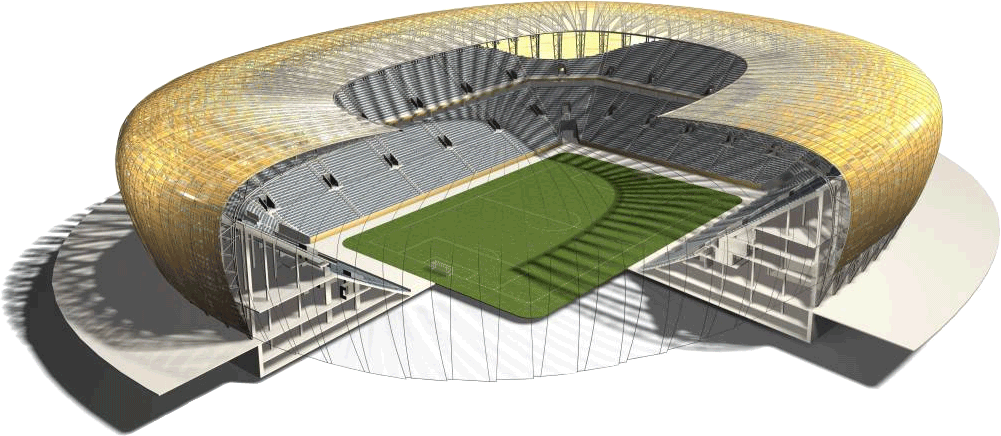Polsat Plus Arena Gdańsk (Stadion Gdańsk)
| Capacity | 41 620 |
|---|---|
| 480 (37 skyboxes) (VIP seats) | |
| 1,383 (Business seats) | |
| 66+66 (Disabled seats) | |
| Country | Poland |
| City | Gdańsk |
| Clubs | Lechia Gdańsk S.A. |
| Other names | PGE Arena Gdańsk (2010-2015), Stadion Energa Gdańsk (2015-2020), Lechia Gdansk Stadium (nickname) |
| Inauguration | 06/08/2011 |
| Construction | 28/05/2009 – 18/07/2011 |
| Renovations | 2016 |
| Record attendance | 40,392 (Poland - Netherlands, 01/06/2016) |
| Cost | PLN 864 million |
| Design | Rhode-Kellermann-Wawrowsky |
| Design time | 2006 |
| Contractor | Hydrobudowa Polska- Alpine Bau |
| Address | ul. Pokoleń Lechii Gdańsk 1, 80-560, Gdańsk |
Advertisement
Polsat Plus Arena Gdańsk – stadium description
In Spring 2007 the cost was estimated at PLN 660 mln (app. €170 mln ). By Summer 2011 the number has increased to PLN 864 mln (€213 mln). For three years, starting in mid-2009, whole Poland was watching the progress of the venue initially called Baltic Arena. One of Euro 2012's most spectacular stadiums rised in the Letnica district of Gdansk, though not without delays. First scheduled to be ready for January 2011 was then postponed till April and finally opened in July 2011.

Its appearence and construction is the work of Rhode-Kellermann-Wawrowsky office from Dusseldorf. It was the first stadium designed on their own account, though before they've also been involved in works on other stadia. For Gdansk they chose the form of amber, called „Gold of the Baltic”, in warm, light colours. However, due to appeals of local football supporters stadium seating colours were changed from yellowish to greenish, to resemble the colours of Lechia Gdansk football club.

Two-tiered stands are surrounded by 82 supports bearing the roof and facades.With each segment weighing 66 tons, the primary dome weighs over 5,400 tons, while all of the steel structure sums up at 6,500 tons.
The whole venue is covered in 6 tints of polycarbonate panels that reflect sunshine at daytime and at night are illuminated to give a yellow glow. In total the cladding covers 4.5 hectares.
Underneath this cover there are 53,000 square meters of space for administrative and commercial use. Around the venue a rollerblade track was created and beyond it fans will find 2,171 parking bays for cars and another 74 for coaches.
The Gdansk stadium is also the first Polish example of naming rights contract (similar case from Lubin isn't a classic naming rights deal due to the stadium and sponsor being part of the same company). Energy company PGE bought the arena's name for 5 years, paying a total of PLN 35 mln (app. €9 mln). After the deal ran out, stadium name changed to Stadion Energa, under contract with another energy supplier.
Advertisement
Pictures
-

25.09.2023 © Grzegorz Kaliciak 
25.09.2023 © Grzegorz Kaliciak 
25.09.2023 © Grzegorz Kaliciak 
25.09.2023 © Grzegorz Kaliciak 
25.09.2023 © Grzegorz Kaliciak 
25.09.2023 © Grzegorz Kaliciak 
25.09.2023 © Grzegorz Kaliciak 
25.09.2023 © Grzegorz Kaliciak 
25.09.2023 © Grzegorz Kaliciak 
25.09.2023 © Grzegorz Kaliciak 
25.09.2023 © Grzegorz Kaliciak 
25.09.2023 © Grzegorz Kaliciak 
25.09.2023 © Grzegorz Kaliciak 
25.09.2023 © Grzegorz Kaliciak 
25.09.2023 © Grzegorz Kaliciak 
25.09.2023 © Grzegorz Kaliciak 
25.09.2023 © Grzegorz Kaliciak 
25.09.2023 © Grzegorz Kaliciak 
25.09.2023 © Grzegorz Kaliciak 
25.09.2023 © Grzegorz Kaliciak 
25.09.2023 © Grzegorz Kaliciak 
25.09.2023 © Grzegorz Kaliciak 
25.09.2023 © Grzegorz Kaliciak 
25.09.2023 © Grzegorz Kaliciak 
25.09.2023 © Grzegorz Kaliciak 
25.09.2023 © Grzegorz Kaliciak 
25.09.2023 © Grzegorz Kaliciak 
25.09.2023 © Grzegorz Kaliciak 
25.09.2023 © Grzegorz Kaliciak 
22.09.2023 © Grzegorz Kaliciak 
22.09.2023 © Grzegorz Kaliciak 
22.09.2023 © Grzegorz Kaliciak 
22.09.2023 © Grzegorz Kaliciak 
22.09.2023 © Grzegorz Kaliciak 
22.09.2023 © Grzegorz Kaliciak 
22.09.2023 © Grzegorz Kaliciak 
22.09.2023 © Grzegorz Kaliciak 
22.09.2023 © Grzegorz Kaliciak 
22.09.2023 © Grzegorz Kaliciak 
19.10.2013 © Stadiony.net 
19.10.2013 © Stadiony.net 
20.08.2018 © Stadiony.net 
20.08.2018 © Stadiony.net 
20.08.2018 © Stadiony.net 
20.08.2018 © Stadiony.net 
20.08.2018 © Stadiony.net 
20.08.2018 © Stadiony.net 
20.08.2018 © Stadiony.net 
20.08.2018 © Stadiony.net 
20.08.2018 © Stadiony.net 
20.08.2018 © Stadiony.net 
20.08.2018 © Stadiony.net 
20.08.2018 © Stadiony.net 
20.08.2018 © Stadiony.net 
20.08.2018 © Stadiony.net 
20.08.2018 © Stadiony.net 
20.08.2018 © Stadiony.net 
20.08.2018 © Stadiony.net 
20.08.2018 © Stadiony.net 
20.08.2018 © Stadiony.net 
20.08.2018 © Stadiony.net 
20.11.2011 © Dariusz Boczek, Lechia.net 
19.10.2013 © Stadiony.net 
19.10.2013 © Stadiony.net 
16.06.2015 © Grzegorz Kaliciak / StadiumDB.com 
16.06.2015 © Grzegorz Kaliciak / StadiumDB.com 
11.04.2015 © PGE Arena Gdańsk 
11.04.2015 © PGE Arena Gdańsk
Related news
2024
2022
2021
-

Poland: Gdańsk ready for Europa League final
The crowd may be limited to 10,000 but atmosphere is festive enough. For Gdańsk it’s a return to normal life and live events, while both sets of fans are prepared to cheer for their teams.
-

Poland: Gdańsk strikes naming rights deal just before EL final
While the stadium is being decorated for the upcoming Europa League final, the stadium has gained a new naming rights holder. To make it slightly weirder, there will be two different commercial brands in its name...
-

Europa League: Villarreal want to dominate Gdańsk
Though they’re far smaller than Manchester United, Villarreal want to stage a yellow invasion of the yellowish stadium in Gdańsk. They’re hoping to get 2,000 more tickets for the limited-capacity game.
2020
-

COVID-19 crisis: Poland to allow 10,000 people per game
Starting June 19 Polish football clubs will be able to welcome even upwards of 10,000 people at their stadiums. The news came as a surprise even to the Polish FA (PZPN), who were only asking for 999 people...
-

COVID-19 crisis: European football rescheduled
Euro 2020 is no more, get ready for Euro 2021. International games and cup finals also have a new schedule in effort to allow domestic competitions to conclude this summer.
-

Gdansk: Stadion Energa going all-LED before UEL final
Though still not even a decade old, Stadion Energa will undergo a major technological upgrade ahead of this year's UEFA Europa League final. In order to save on energy and maintenance cost, the stadium switches to all-LED lighting.
2018
2017
-

Poland: Safe standing just one step away
After two years we're finally just a step away from safe standing being legal in Poland. Supporters should expect the law to go into effect before year end!
-

UEFA: 11 stadiums compete for 2019 finals
Champions League, Women's Champions League, Europa League and Super Cup will all see final venues selected among these 10 contenders.
-

UEFA: Who gets the 2019 club finals?
15 national associations expressed interest in hosting of the 2019 finals. Champions League, Europa League, Women’s Champions League and Super Cup will be decided among 19 stadia!
2016
-

Poland: Supporters design better law than the MPs
It’s not a joke, though we couldn’t believe it ourselves. Polish federation of football supporters announced their grassroots plan to amend current stadium safety legislation. In the best way possible.
-

Forum Seating: Comfort for sports fans
Polish chairs are becoming more and more popular across Europe – after the very successful implementation at the Hungarian Groupama Aréna, further projects were only a matter of time. Nowy Styl Group has already supplied the Abacus chairs to the Grand Stade stadium in Lyon and to the Allianz Riviera stadium in Nice where European Championship 2016 will be held.
2015
-

Poland: Gdansk stadium with new naming rights deal
It was the first Polish stadium to commercialise its name, now Arena Gdansk signed a new 5-year deal with one more energy provider. Until 2020 the stadium will be named Stadion Energa Gdańsk.
-

Poland: Better access to domestic football
President Andrzej Duda signed new legislation regarding stadium safety in Poland. Clubs and league operators are preparing to welcome new fans who may have been discouraged before.
-

10+ Ranking 2015: Attendances in Europe (Part 2. The Clubs)
Borussia, Barca and Man United – lovely dominant trio. But it wasn’t them who gained most fans last season. Check all 217 clubs that draw an average crowd of 10,000+!
-

Warsaw: Narodowy signs naming rights deal with PGE
Polish energy provider PGE agreed terms with Stadion Narodowy. The new naming rights contract may be largest for any Polish stadium so far.
-

Poland: Ekstraklasa season in a nutshell
Hardly the best year in terms of attendance, but Ekstraklasa continues to grow stadium-wise. Thankfully what’s falling most is the number of incidents.
-

Poland: Arena Gdansk with optimistic financial results
The largest stadium of Polish league is hardly ever full, but still manages to generate profits. Once debt is paid off, it should begin to flourish. But… not everything is certain just yet.

 StadiumDB
StadiumDB

